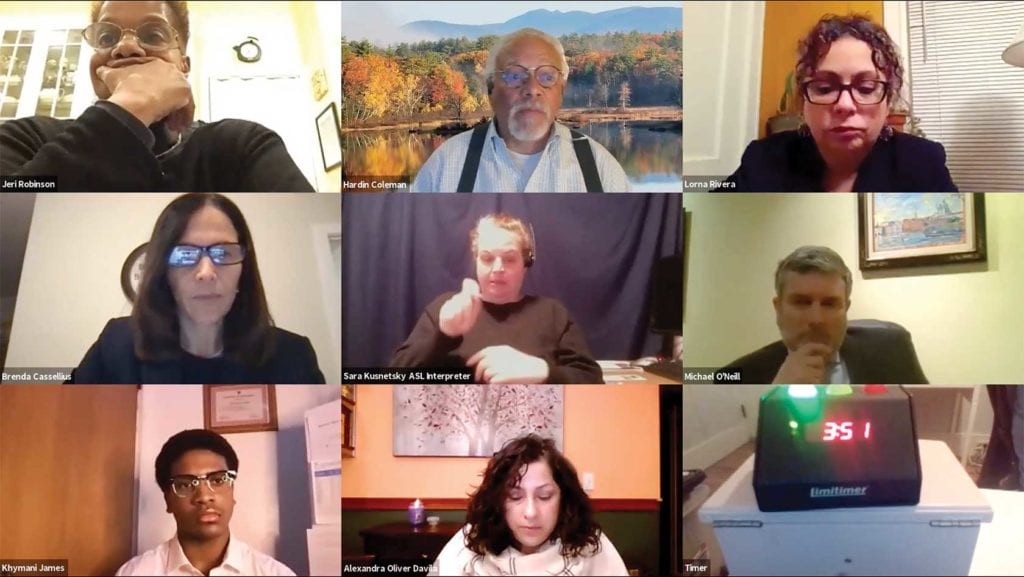BPS students question in-school instruction push
Some cite city’s high infection rates, argue for remote

The Boston Teachers Union have come to yet another agreement with the Boston School Committee on how to reopen schools in 2021, and Boston Public Schools Superintendent Brenda Cassellius and Boston Teachers Union President Jessica Tang have both expressed that they want students back in school as soon as it is safe.
But some students who testified at the Jan. 13 School Committee meeting expressed doubts about their schools’ capacity to safely accommodate students, citing CDC guidelines.
Transmission in schools is low, but safety is not guaranteed, student representative Khymani James pointed out.
He presented the CDC’s “indicators and thresholds for risk of introduction and transmission of COVID-19 in schools,” a table that specifies the lowest-to-highest-risk situations schools could be in based on the number of COVID-19 cases in surrounding communities.
According to the table, schools with the highest risk of transmission are located in communities with greater than 200 new cases per 100,000 people within the last 14 days. Boston’s average was 942 per 100,000, James noted.
“I put this presentation together because I felt it was necessary for my colleagues to understand the context of what is going on in the city,” James said before questioning the superintendent about the safety of each school’s protocols.
“I personally am very much for students returning. I just want to make sure that we’re doing it in the most safe way possible. Looking at these numbers … it’s very scary,” James said. “I know BPS is doing everything they can when it comes to the school front, but you all cannot control what people who don’t go to school in this city do.”
The original agreement between BPS and BTU set a threshold of 5% positive cases and was later disputed by the city after Boston reached a 4.9% rate. The new agreement, announced last week, increases some protocols like air quality testing and PPE distribution, but it does not offer a threshold for closing schools.
There is no percentage of positive cases where BPS, the Boston Public Health Commission or the BTU will send students home. They have however set a 10% mark at which the union can come back to the table to renegotiate protocols.
Cady Malkemes, a senior at Boston Arts Academy, said she worked closely with James and thinks he should have a vote in the matter. The student representative on the school committee is the only non-voting member.
“Students desire to be a part of the work. Let’s continue the progression our district is making towards being a more inclusive system by actively advocating for our students to not only be present in these spaces, but to be equally included in these spaces,” Malkemes said.
Jada Saint Louis, a senior at Boston Arts Academy, also thanked James for his work. “Not only did the space he created feel safe, it was engaging and understandable. And there wasn’t a use of jargon, or what I like to call fancy words,” Saint Louis said.
Damian Durgin is a student at the MLK school who is against returning to school while numbers are high. “Why would we open it back up and we have a thousand times more cases? It just doesn’t make sense in my mind,” Durgin said.
The other core indicators the CDC notes are ability to implement key mitigation strategies and the percentage of positive PCR tests (not rapid tests). They also list secondary indicators, like the percentage of occupied hospital beds, percentage of occupied ICU beds, and more.
Parents also signed up for public testimony, and some were in favor of reopening so that their children can have a somewhat normal learning experience.
“Last Friday, on January 7, governor Baker stated, quote, ‘There is now an overwhelming body of scientific evidence that in-person learning can be done without spreading the virus, regardless of the community transmission rates,’” said Erica Haydock, parent of a BPS kindergarten student. “Why does the timeline released by the district, [have] students waiting until March to return to the classroom?”
But the students who testified were focused on following CDC guidelines. BPS student Charlie Adames-Pimentel said, “I feel like calling CDC and reporting Boston, like, what is going on? Are we changing COVID methodology to trick our communities into thinking that in-person learning is safe? I’m hearing no type of transparency from anyone but Khymani James.”






